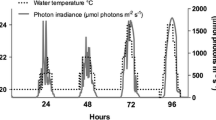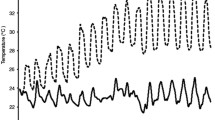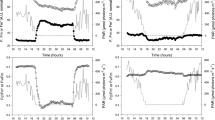Abstract
Changing light environments force photoautotroph cells, including coral symbionts, to acclimate to maintain photosynthesis. Photosystem II (PSII) is subjected to photoinactivation at a rate proportional to the incident light, and cells must adjust their rates of protein repair to counter this photoinactivation. We examined PSII function in the coral symbiont Symbiodinium to determine the effect of photoacclimation on their capacity for PSII repair. Colonies of the coral Stylophora pistillata were collected from moderate light environments on the Lizard Island reef (Queensland, Australia) and transported to a local field station, where they were assigned to lower or higher light regimes and allowed to acclimate for 2 weeks. Following this photoacclimation period, the low-light acclimated corals showed greater symbiont density, higher chlorophyll per symbiont cell, and higher photosystem II protein than high-light acclimated corals did. Subsequently, we treated the corals with lincomycin, an inhibitor of chloroplastic protein synthesis, and exposed them to a high-light treatment to separate the effect of de novo protein synthesis in PSII repair from intrinsic susceptibility to photoinactivation. Low-light acclimated corals showed a sharp initial drop in PSII function but inhibition of PSII repair provoked only a modest additional drop in PSII function, compared to uninhibited corals. In high-light acclimated corals inhibition of PSII repair provoked a larger drop in PSII function, compared to uninhibited high-light corals. The greater lincomycin effects in the corals pre-acclimated to high-light show that high-light leads to an increased reliance on the PSII repair cycle.





Similar content being viewed by others
References
Adir N, Zer H, Shochat S, Ohad I (2003) Photoinhibition—a historical perspective. Photosyn Res 76:343–370. doi:10.1023/A:1024969518145
Anthony KRN, Ridd PV, Orpin AR et al (2004) Temporal variation of light availability in coastal benthic habitats: effects of clouds, turbidity, and tides. Limnol Oceanogr 49:2201–2211
Brown BE, Downs CA, Dunne RP, Gibb SW (2002) Exploring the basis of thermotolerance in the reef coral Goniastrea aspera. Mar Ecol Prog Ser 242:119–129. doi:10.3354/meps242119
Buxton L, Takahashi S, Hill R, Ralph PJ (2012) Variability in the primary site of photosynthetic damage in Symbiodinium sp. (Dinophyceae) exposed to thermal stress. J Phycol 48:117–126. doi:10.1111/j.1529-8817.2011.01099.x
Campbell DA, Tyystjärvi E (2012) Parameterization of photosystem II photoinactivation and repair. Biochim Biophys Acta 1817:258–265. doi:10.1016/j.bbabio.2011.04.010
Chalker BE (1981) Simulating light-saturation curves for photosynthesis and calcification by reef-building corals. Mar Biol 63:135–141. doi:10.1007/BF00406821
Cunning R, Baker AC (2013) Excess algal symbionts increase the susceptibility of reef corals to bleaching. Nature Clim Change 3:259–262. doi:10.1038/nclimate1711
Demmig-Adams B, Adams WW III (1996) The role of xanthophyll cycle carotenoids in the protection of photosynthesis. Trends Plant Sci 1:21–26. doi:10.1016/S1360-1385(96)80019-7
Dubinsky Z, Falkowski PG, Porter JW, Muscatine L (1984) Absorption and utilization of radiant energy by light- and shade-adapted colonies of the hermatypic coral Stylophora pistillata. Proc R Soc Lond B 222:203–214. doi:10.1098/rspb.1984.0059
Edelman M, Mattoo AK (2008) D1-protein dynamics in photosystem II: the lingering enigma. Photosynth Res 98:609–620. doi:10.1007/s11120-008-9342-x
Enriquez S, Mendez ER, Iglesias-Prieto R (2005) Multiple scattering on coral skeletons enhances light absorption by symbiotic algae. Limnol Oceanogr 50:1025–1032
Fabricius KE (2005) Effects of terrestrial runoff on the ecology of corals and coral reefs: review and synthesis. Mar Pollut Bull 50:125–146. doi:10.1016/j.marpolbul.2004.11.028
Falkowski PG, Dubinsky Z (1981) Light-shade adaptation of Stylophora pistillata, a hermatypic coral from the Gulf of Eilat. Nature 289:172–174. doi:10.1038/289172a0
Fine M, Loya Y (2002) Endolithic algae: an alternative source of photoassimilates during coral bleaching. Proc Biol Sci 269:1205–1210. doi:10.1098/rspb.2002.1983
Frade PR, Bongaerts P, Winkelhagen AJS et al (2008) In situ photobiology of corals over large depth ranges: a multivariate analysis on the roles of environment, host, and algal symbiont. Limnol Oceanogr 53:2711–2723. doi:10.4319/lo.2008.53.6.2711
Gorbunov MY, Kolber ZS, Lesser MP, Falkowski PG (2001) Photosynthesis and photoprotection in symbiotic corals. Limnol Oceanogr 46:75–85. doi:10.4319/lo.2001.46.1.0075
Hennige S, Smith D, Perkins R et al (2008a) Photoacclimation, growth and distribution of massive coral species in clear and turbid waters. Mar Ecol Prog Ser 369:77–88. doi:10.3354/meps07612
Hennige SJ, Suggett DJ, Warner ME et al (2008b) Photobiology of Symbiodinium revisited: bio-physical and bio-optical signatures. Coral Reefs 28:179–195. doi:10.1007/s00338-008-0444-x
Hennige SJ, McGinley MP, Grottoli AG, Warner ME (2011) Photoinhibition of Symbiodinium spp. within the reef corals Montastraea faveolata and Porites astreoides: implications for coral bleaching. Mar Biol 158:2515–2526. doi:10.1007/s00227-011-1752-1
Hill R, Ralph PJ (2006) Photosystem II heterogeneity of in hospite zooxanthellae in scleractinian corals exposed to bleaching conditions. Photochem Photobiol 82:1577–1585. doi:10.1111/j.1751-1097.2006.tb09814.x
Hill R, Frankart C, Ralph PJ (2005) Impact of bleaching conditions on the components of non-photochemical quenching in the zooxanthellae of a coral. J Exp Mar Biol Ecol 322:83–92. doi:10.1016/j.jembe.2005.02.011
Hill R, Brown CM, DeZeeuw K et al (2011) Increased rate of D1 repair in coral symbionts during bleaching is insufficient to counter accelerated photo-inactivation. Limnol Oceanogr 56:139–146. doi:10.4319/lo.2011.56.1.0139
Hoegh-Guldberg O (1999) Climate change, coral bleaching and the future of the world’s coral reefs. Mar Freshwater Res 50:839–866
Hoegh-Guldberg O (2011) Coral reef ecosystems and anthropogenic climate change. Reg Environ Change 11:215–227. doi:10.1007/s10113-010-0189-2
Hoogenboom MO, Campbell DA, Beraud E et al (2012) Effects of light, food availability and temperature stress on the function of photosystem II and photosystem I of coral symbionts. PLoS One 7:e30167. doi:10.1371/journal.pone.0030167
Iglesias-Prieto R, Trench RK (1994) Acclimation and adaptation to irradiance in symbiotic dinoflagellates. I. Responses of the photosynthetic unit to changes in photon flux density. Mar Ecol Prog Ser 113:163–175
Iglesias-Prieto R, Trench RK (1997) Acclimation and adaptation to irradiance in symbiotic dinoflagellates. II. Response of chlorophyll–protein complexes to different photon-flux densities. Mar Biol 130:23–33. doi:10.1007/s002270050221
Jeffrey S, Humphrey G (1975) New spectrophotometric equations for determining chlorophyll a, b, c 1 and c 2 in higher plants, algae and natural phytoplankton. Biochemie und Physiologie der Pflanzen 167:191–194
Jimenez IM, Larkum AWD, Ralph PJ, Kühl M (2012) Thermal effects of tissue optics in symbiont-bearing reef-building corals. Limnol Oceanogr 57:1816–1825. doi:10.4319/lo.2012.57.6.1816
Kuguru B, Achituv Y, Gruber DF, Tchernov D (2010) Photoacclimation mechanisms of corallimorpharians on coral reefs: photosynthetic parameters of zooxanthellae and host cellular responses to variation in irradiance. J Exp Mar Biol Ecol 394:53–62. doi:10.1016/j.jembe.2010.07.007
Kushmaro A, Loya Y, Fine M, Rosenberg E (1996) Bacterial infection and coral bleaching. Nature 380:396. doi:10.1038/380396a0
Lesser M, Farrell J (2004) Exposure to solar radiation increases damage to both host tissues and algal symbionts of corals during thermal stress. Coral Reefs 23:367–377. doi:10.1007/s00338-004-0392-z
Lesser MP, Shick JM (1989) Effects of irradiance and ultraviolet radiation on photoadaptation in the zooxanthellae of Aiptasia pallida: primary production, photoinhibition, and enzymic defenses against oxygen toxicity. Mar Biol 102:243–255. doi:10.1007/BF00428286
Lesser MP, Falcn LI, RodrguezRomn A et al (2007) Nitrogen fixation by symbiotic cyanobacteria provides a source of nitrogen for the scleractinian coral Montastraea cavernosa. Mar Ecol Prog Ser 346:143–152. doi:10.3354/meps07008
Marshall PA, Baird AH (2000) Bleaching of corals on the Great Barrier Reef: differential susceptibilities among taxa. Coral Reefs 19:155–163. doi:10.1007/s003380000086
Mass T, Einbinder S, Brokovich E et al (2007) Photoacclimation of Stylophora pistillata to light extremes: metabolism and calcification. Mar Ecol Prog Ser 334:93–102. doi:10.3354/meps334093
Mulo P, Pursiheimo S, Hou C-X et al (2003) Multiple effects of antibiotics on chloroplast and nuclear gene expression. Funct Plant Biol 30:1097–1103
Muscatine L (1990) The role of symbiotic algae in carbon and energy flux in reef corals. Coral Reefs 25:1–29
Nixon P, Michoux F, Yu J et al (2010) Recent advances in understanding the assembly and repair of photosystem II. Ann Bot 106:1–16. doi:10.1093/aob/mcq059
Ragni M, Airs RL, Leonardos N, Geider RJ (2008) Photoinhibition of PSII in Emiliania huxleyi (Haptophyta) under high light stress: the roles of photoacclimation, photoprotection, and photorepair. J Phycol 44:670–683. doi:10.1111/j.1529-8817.2008.00524.x
Ragni M, Airs RL, Hennige SJ et al (2010) PSII photoinhibition and photorepair in Symbiodinium (Pyrrhophyta) differs between thermally tolerant and sensitive phylotypes. Mar Ecol Prog Ser 406:57–70. doi:10.3354/meps08571
Ralph PJ, Gademann R (2005) Rapid light curves: a powerful tool to assess photosynthetic activity. Aquat Bot 82:222–237. doi:10.1016/j.aquabot.2005.02.006
Ritchie RJ (2006) Consistent sets of spectrophotometric chlorophyll equations for acetone, methanol and ethanol solvents. Photosynth Res 89:27–41. doi:10.1007/s11120-006-9065-9
Robison JD, Warner ME (2006) Differential impacts of photoacclimation and thermal stress on the photobiology of four different phylotypes of Symbiodinium (pyrrhophyta)1. J Phycol 42:568–579. doi:10.1111/j.1529-8817.2006.00232.x
Smith DJ, Suggett DJ, Baker NR (2005) Is photoinhibition of zooxanthellae photosynthesis the primary cause of thermal bleaching in corals? Glob Change Biol 11:1–11. doi:10.1111/j.1529-8817.2003.00895.x
Stambler N, Dubinsky Z (2005) Corals as light collectors: an integrating sphere approach. Coral Reefs 24:1–9. doi:10.1007/s00338-004-0452-4
Stimson J, Kinzie RA III (1991) The temporal pattern and rate of release of zooxanthellae from the reef coral Pocillopora damicornis (Linnaeus) under nitrogen-enrichment and control conditions. J Exp Mar Biol Ecol 153:63–74. doi:10.1016/S0022-0981(05)80006-1
Takahashi S, Nakamura T, Sakamizu M et al (2004) Repair machinery of symbiotic photosynthesis as the primary target of heat stress for reef-building corals. Plant Cell Physiol 45:251–255. doi:10.1093/pcp/pch028
Titlyanov E, Titlyanova T, Yamazato K, Van Woesik R (2001a) Photo-acclimation dynamics of the coral Stylophora pistillata to low and extremely low light. J Exp Mar Biol Ecol 263:211–225. doi:10.1016/S0022-0981(01)00309-4
Titlyanov EA, Titlyanova TV, Yamazato K, Van Woesik R (2001b) Photo-acclimation of the hermatypic coral Stylophora pistillata while subjected to either starvation or food provisioning. J Exp Mar Biol Ecol 257:163–181. doi:10.1016/S0022-0981(00)00308-7
Tyystjärvi E (2013) Photoinhibition of photosystem II. Int Rev Cell Mol Biol 300:243–303
Tyystjärvi E, Ali-Yrkkö K, Kettunen R, Aro E-M (1992) Slow degradation of the D1 protein is related to the susceptibility of low-light-grown pumpkin plants to photoinhibition. Plant Physiol 100:1310–1317. doi:10.1104/pp.100.3.1310
Ulstrup KE, Hill R, van Oppen MJH et al (2008) Seasonal variation in the photo-physiology of homogeneous and heterogeneous Symbiodinium consortia in two scleractinian corals. Mar Ecol Prog Ser 361:139–150. doi:10.3354/meps07360
Vass I (2012) Molecular mechanisms of photodamage in the Photosystem II complex. Biochim Biophys Acta 1817:209–217. doi:10.1016/j.bbabio.2011.04.014
Warner ME, Fitt WK, Schmidt GW (1999) Damage to photosystem II in symbiotic dinoflagellates: a determinant of coral bleaching. Proc Natl Acad Sci USA 96:8007–8012
Warner M, Chilcoat G, McFarland F, Fitt W (2002) Seasonal fluctuations in the photosynthetic capacity of photosystem II in symbiotic dinoflagellates in the Caribbean reef-building coral Montastraea. Mar Biol 141:31–38. doi:10.1007/s00227-002-0807-8
Wu H, Cockshutt AM, McCarthy A, Campbell DA (2011) Distinctive photosystem II photoinactivation and protein dynamics in marine diatoms. Plant Physiol 156:2184–2195. doi:10.1104/pp.111.178772
Wu H, Roy S, Alami M et al (2012) Photosystem II photoinactivation, repair, and protection in marine centric diatoms. Plant Physiol 160:464–476. doi:10.1104/pp.112.203067
Yentsch C, Yentsch C, Cullen J et al (2002) Sunlight and water transparency: cornerstones in coral research. J Exp Mar Biol Ecol 268:171–183. doi:10.1016/S0022-0981(01)00379-3
Acknowledgments
We thank L. Langlois for performing symbiont counts and surface area determinations, M. Rocker for assistance with sample collection and tissue blasting and the staff of Lizard Island Research Station for facilitating this project. This work was supported by the Natural Sciences and Engineering Research Council of Canada (NSERC) Canada Research Chair funding (DC), Canada Graduate Scholarships (JJ), and James Cook University (MH). The research was conducted under GBR Marine Park Authority permit number G12/35052.1.
Author information
Authors and Affiliations
Corresponding author
Rights and permissions
About this article
Cite this article
Jeans, J., Campbell, D.A. & Hoogenboom, M.O. Increased reliance upon photosystem II repair following acclimation to high-light by coral-dinoflagellate symbioses. Photosynth Res 118, 219–229 (2013). https://doi.org/10.1007/s11120-013-9918-y
Received:
Accepted:
Published:
Issue Date:
DOI: https://doi.org/10.1007/s11120-013-9918-y




